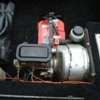quote:
Originally posted by George P:
Snake a chain through the D3ZE manifold and use it an anchor for your fishing boat ... that's about all it is good for.
Every 1970 - 1974 351C 4V is better-off with a Blue Thunder manifold and a Demon Carburetors #1402020VE carburetor rather than the factory induction (including the De Tomaso single four barrel induction).
-G
That could be harmful to the environment. It should be recycled.
The carb recommended by Ford through the "Muscle Perts" program back in the day, was the 4181. That is the 850 double pumper with the 50cc secondary pump.
Their information claimed it was worth 15hp over other carbs on that engine. Probably any double pumper is but blame John Vermersch (now head of the Ford "Racing" aftermarket parts program) for these writings and recommendations. That was his job back then.
Dan Jones dyno testing "program" showed that the Blue Thunder needs runner modifications. It showed that the manifold has four good runners and four "bad" runners.
His partner in that program was able to port the manifold to somewhat equalize the runner flow balance. That you need to be very knowledgeable and talented to be able to do, not to mention having a flow bench at your service.
Back in the day I ran the Shelby version of that manifold and in the days of only a "seat of the pants dyno test" available found that the Edelbrock Torker was worth several 1/10s in the 1/4 over the Shelby.
The Shelby manifold was more suited to a Cleveland running an automatic transmission. On a manual trans car, especially using a solid lifter cam like the Boss351 version, it really is a dog, and not a Greyhound either.
With original iron 4v heads now, maybe the "Ford" script manifold to run would be the "Ford Motorsport" A341? That is a FORD modified casting of the Edelbrock Torker manifold with stuffer plugs built into the port runners at the ports to match the A3 heads.
I have one here to show you if you want to see it.
Since it is a modification of the Edelbrock molds, identical on the outside EXCEPT FOR THE ELIMINATION OF THE CHOKE HEAT CHAMBER UNDERNEATH, it will still bolt up to the 4v Ford iron heads. It has to be worth some horsepower over the regular Torker and certainly crispins up the throttle noticeably.
They are not common and not easy to find but they are worth the effort. It is arguably the best Ford logo single 4v manifold available.
With that manifold you can then take your pick of what Holley carb to run with. I found that a 4179, a 750dp was about right. Be warned though that carb is very rich at idle and will smart your eyes from the fumes.
Of course all of this depends on the camshaft you are going to use. Forget about the original 4v CJ hydraulic unit. But that all starts up another thread? Not to mention a "tuned" set of headers?

What George has said about camshafts, I would have to agree with. Factory cams are much more comfortable to live with in everyday driving. High performance cars in general, are not what you want to drive everyday as your everyday car. I'd rather drive a truck to be honest with you.
The "stock" Pantera's engine characteristics were a consideration of this delema. It was intended as an "everyday" use sports car, and for many was their only car.
For racing though, it is really too mild stock.


